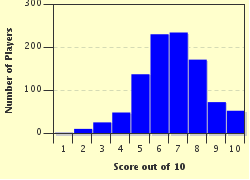Quiz Answer Key and Fun Facts
1. For what important document was Martin Luther responsible?
2. Which Russian leader expanded Russia's borders to the Black Sea after defeating Ottoman Turks, partitioned Poland and commissioned the famous "Bronze Horseman" statue that stands in St. Petersburg?
3. Under which Chinese dynasty were the Opium Wars fought?
4. Between what two rivers did Mesopotamia develop?
5. Most American presidents have been members of either the Republican or Democratic parties. Some lesser-known political parties have been represented in the executive branch in America's 200-plus years of existence. Which of the following political parties has an elected president belonged to?
6. Which of the following is NOT a name associated with the first World War?
7. What revolutionary is credited with leading Haiti to freedom from French rule?
8. Which sea route runs along the southern tip of Chile, first navigated in 1520?
9. Apartheid was a system of racial separation and segregation in what African country?
10. What are the two major religions in India?
Source: Author
KBCoffelt
This quiz was reviewed by FunTrivia editor
bloomsby before going online.
Any errors found in FunTrivia content are routinely corrected through our feedback system.

